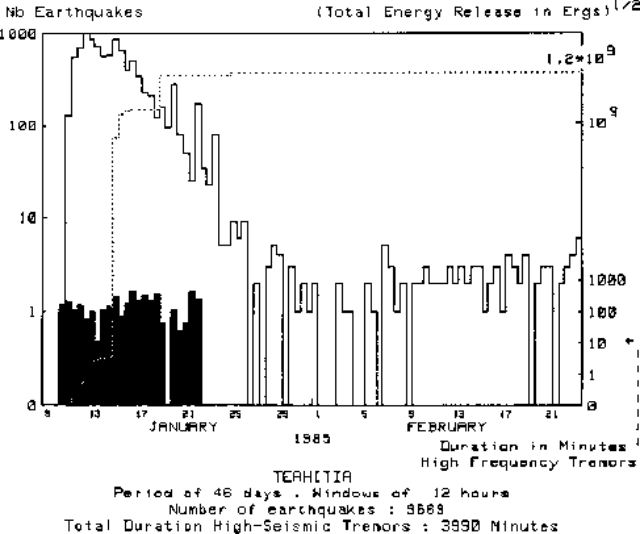Report on Teahitia (France) — January 1985
Scientific Event Alert Network Bulletin, vol. 10, no. 1 (January 1985)
Managing Editor: Lindsay McClelland.
Teahitia (France) Earthquake swarm and probable submarine eruption
Please cite this report as:
Global Volcanism Program, 1985. Report on Teahitia (France) (McClelland, L., ed.). Scientific Event Alert Network Bulletin, 10:1. Smithsonian Institution. https://doi.org/10.5479/si.GVP.SEAN198501-333010
Teahitia
France
17.564°S, 148.821°W; summit elev. -1743 m
All times are local (unless otherwise noted)
Between 11 and 22 January, RSP stations on Tahiti recorded about 10,000 seismic events near Teahitia (figure 4). From 15-19 January, about 50 seismic events stronger than ML 3.5 were recorded. A number of those were felt by some of the inhabitants of Tahiti, 40 km SW, and three, of magnitudes 4.0, 4.2, and 4.4, were felt by the entire population. Very intense, high-frequency, long-duration volcanic tremors were recorded 19 January. Talandier noted that the intensity and duration of the tremors pointed to magmatic transfer. He also stated that this swarm certainly led to a submarine eruption, as did previous swarms. There were more events and greater seismic energy release in the January swarm than in previous swarms in April-May 1982, July and December 1983, and April-May 1984. Only the 1982 swarm had stronger deep activity.
Geological Summary. Teahitia is a submarine volcano in the Society Islands whose summit reaches to within ~1,700 m of the surface, 40 km NE of the SE tip of Tahiti Island. Several seismic swarms in the 1980s included volcanic tremor that may have resulted from submarine eruptions (Talandier and Opal, 1984). Rocks dredged in 1986 "exploded" when they reached the surface, suggesting recent lava extrusion that had not yet had time to equilibrate with pressure and temperature conditions on the submerged flanks of the edifice. Two hydrothermal fields each about 400 x 1,000 m exhibiting low-temperature hydrothermal venting were discovered on the flanks during submersible dives in 1986 and 1989.
Information Contacts: J.M. Talandier, Lab. de Géophysique, Tahiti.


